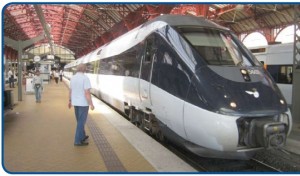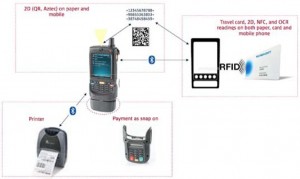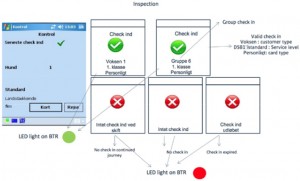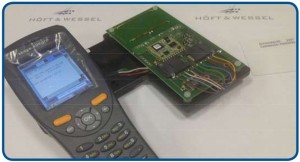Jesper Frederik Gottlieb is project manager leading various special projects within the Danish State Rail. He has a five year track record of success in the management of business and IT critical projects for Danish State Rail and the past three years with solid experience within the field of mobile solutions. His experience covers all phases and processes in managed business and IT projects from initiation to closing over durations ranging from months to years, from small applications to multi-year programs and from single-user departments to nation-wide rollouts.
An overview of the development of a wireless extension tool for handhelds used for inspecting e-tickets in passenger transport
 Danish State Railways (DSB) is an independent public corporation serving over 156 million passengers annually, with a staff of 8,400 employees. In recent years, the company has upgraded its InterCity rail system with 332 new 4-car train sets, and 44 new double-decker cars for regional services, which is expected to increase passenger traffic by 25 percent. In order to remain their customers’ preferred means of travel, DSB focuses on improving customer service and efficiency as well as saving time and costs. ID People caught up with Jesper Frederik Gottlieb, project manager with the company, who discussed the challenges Danish State Railways faced in streamlining their onboard ticket-selling process to provide better communications with conductors and crews and the building of a multi-modal wireless platform for e-ticketing.
Danish State Railways (DSB) is an independent public corporation serving over 156 million passengers annually, with a staff of 8,400 employees. In recent years, the company has upgraded its InterCity rail system with 332 new 4-car train sets, and 44 new double-decker cars for regional services, which is expected to increase passenger traffic by 25 percent. In order to remain their customers’ preferred means of travel, DSB focuses on improving customer service and efficiency as well as saving time and costs. ID People caught up with Jesper Frederik Gottlieb, project manager with the company, who discussed the challenges Danish State Railways faced in streamlining their onboard ticket-selling process to provide better communications with conductors and crews and the building of a multi-modal wireless platform for e-ticketing.
What requirements needed to be met given the scope of the new system?
The introduction of the Danish nationwide Travel Card system and of machine readable codes on paper and on mobile ticket has set new requirements for the handheld unit used by the train, metro and bus inspectors. The scope of project was to develop a solution fulfilling all requirements and roll it out in production within two years.
While the Travel Card was rolling out under high political and media attention, there was neither an off-the-shelf solution nor even a commonly recognized concept to base the solution on. The belief in a successful outcome varied somewhat among stakeholders.
The outline of the resulting device, was conceived early in the project’s vision, but a dedicated external scanning of possible solution done by Gartner Group was required for project approval, and all along the project stakeholders, and in particular the union and end users have been closely involved to ensure the most useful solution: from vision and sketches to clay mockup, from open frame to prototype.
How were the criteria for successful implementation evaluated?
 Getting the ergonomics right was a key success criterion and the result is a lightweight, ergonomic handheld reader unit enabling e-tickets inspections by RFID, NFC OCR and barcode. The reader connects to the main inspection device hanging in the belt by Bluetooth: hence the unit is named a BTR – Blue Tooth Reader. We believe the BTR is the world’s first wireless extension tool for handhelds used for inspecting e-tickets in passenger transport.
Getting the ergonomics right was a key success criterion and the result is a lightweight, ergonomic handheld reader unit enabling e-tickets inspections by RFID, NFC OCR and barcode. The reader connects to the main inspection device hanging in the belt by Bluetooth: hence the unit is named a BTR – Blue Tooth Reader. We believe the BTR is the world’s first wireless extension tool for handhelds used for inspecting e-tickets in passenger transport.
The nationwide roll-out is set to commence December 2012, driven by our set project goal– in time and on budget –to enable efficient and user friendly inspection routines for modern ticket types. The project management experience showed that technical insight cannot alone ensure success, but strong belief and leadership is essential for success. Ascertaining the project value for every single shareholder in order to create and realize this value is another key to success. There was a need to invest a lot of time in a call for tender, test phases and to meet the suppliers on eye level in order to create win-win situations. We also established a Steering Committee with strong involvement and decision making – not on case handling and control – but to develop a successful formula measured on time, budget and quality.
In term of technology, what levels of automatic identifications solutions and modes were considered and deployed?
 Developing a wireless extension tool for handhelds used for inspecting e-tickets in passenger transport required a number of considerations. The introduction of the Danish nationwide Travel Card system (RFID, mifare 4k classic and mifare plus) has set new requirements for the handheld unit used by the train, metro and bus inspectors. The Motorola (MC75) handheld has no sam module, so the current and temporary solution is the HP2790. We set our sights in terms of the scope of project, on developing a nationwide solution fulfilling all requirements (RFID, NFC, 2D, OCR) and to roll it out in production within two years
Developing a wireless extension tool for handhelds used for inspecting e-tickets in passenger transport required a number of considerations. The introduction of the Danish nationwide Travel Card system (RFID, mifare 4k classic and mifare plus) has set new requirements for the handheld unit used by the train, metro and bus inspectors. The Motorola (MC75) handheld has no sam module, so the current and temporary solution is the HP2790. We set our sights in terms of the scope of project, on developing a nationwide solution fulfilling all requirements (RFID, NFC, 2D, OCR) and to roll it out in production within two years
The vision was to develop an ergonomic, generic bluetooth reader for all types of ticketing in train, bus and metro so that end-users will see the BTR as an asset in their work and that all public transport operators (PTO) in Denmark will accept to use it as standard nationwideOverall the goal is to deploy a generic device that is ergonomic, with a secure BT connection, BT stability offering acceptable economy and optimum reading performance.
What were some of the challenges involved during the roll out phase?
 While the Travel Card was rolling out under high political and media attention, there was neither an off-the-shelf solution nor even a commonly recognized concept on which to base the solution. The belief in a successful outcome varied somewhat among stakeholders, but approvals and opinions were sought with a call for an EU tender requiring proof-ofconcept before approval. It is interesting to note that in the end there was no outright winner and therefore the development of an extended BT unit, as a Blue Tooth Reader (BTR) emerged as the only device that fits all our primary specifications. Another challenge was to satisfy the end users without compromising the project. Without a strong involvement of end the users and the union and without considering seriously their needs and requirements, the BTR would never be successful. Based on some of these requirements the BTR was customized, but there was a constant balance between cost and technical complexity on one side of the weight scale and ergonomy and performance on the other.
While the Travel Card was rolling out under high political and media attention, there was neither an off-the-shelf solution nor even a commonly recognized concept on which to base the solution. The belief in a successful outcome varied somewhat among stakeholders, but approvals and opinions were sought with a call for an EU tender requiring proof-ofconcept before approval. It is interesting to note that in the end there was no outright winner and therefore the development of an extended BT unit, as a Blue Tooth Reader (BTR) emerged as the only device that fits all our primary specifications. Another challenge was to satisfy the end users without compromising the project. Without a strong involvement of end the users and the union and without considering seriously their needs and requirements, the BTR would never be successful. Based on some of these requirements the BTR was customized, but there was a constant balance between cost and technical complexity on one side of the weight scale and ergonomy and performance on the other.
How does the device operate in practice and what are the initial roll out numbers?
 The reader connects to the main inspection device hanging in the belt by Bluetooth: hence the unit is named a BTR – Blue Tooth Reader. With a weight of only about 200 grams, the small and ergonomically designed device sets new benchmarks. In times of e-Ticketing, as a result the conductor’s current mechanical validator are replaced by electronic ones, which can identify and read RFID tags, writing (OCR) and 2D barcode on mobile devices.
The reader connects to the main inspection device hanging in the belt by Bluetooth: hence the unit is named a BTR – Blue Tooth Reader. With a weight of only about 200 grams, the small and ergonomically designed device sets new benchmarks. In times of e-Ticketing, as a result the conductor’s current mechanical validator are replaced by electronic ones, which can identify and read RFID tags, writing (OCR) and 2D barcode on mobile devices.
As a first step, 2,000 mobile readers of the new model series with the product name almex.motive are to be supplied and then used by train attendants from early 2013. The delivery of the reader is in connection with the introduction of the ‘Rejsekort’ e-Ticket in Denmark: the card is to be available both as a personalized smartcard and in the form of an anonymized card capable of being charged or topped up. Using the new almex.motive, these cards are to be checked on board of trains in future. This will save money and improve the level of comfort and convenience to passengers. A special feature of the almex.motive is the ability to create a wireless connection (Bluetooth-PAN through a VPN tunnel) with a conventional handheld acting as a host.
Was the overall platform that serves as the hosting or controlling system for DSB operations, originally implemented with view to future developments such as the new wireless ticketing system?
Many of DSB’s employees, such as conductors, train stewards and engineers, have jobs that require them to be mobile. In the past, information needed to perform their jobs, such as train assignments, sale, schedules, passenger counting, rail conditions and repairs, were only available in printed reports or through manual processes. Some years ago, we implemented an on-line, realtime solution to access a range of up-to-the-minute information for the benefit of both customers and our internal operations. This solution – PocketMobile’s PreCom platform allowed DSB to streamline and automatize not only the onboard ticketselling process, but also retail sales, passenger counting and train quality reporting (all online) and provide better communications with conductors and crews.
PreCom is an end-to-end development platform that makes the development of mobile solutions as simple and costeffective as possible.. Approximately 1,500 mobile employees in DSB alone are enabled to operate this new system from their PDA’s.. It supports both on-line (connected via GSM or Wi-fi) and off-line (disconnected) transactions on handheld units, and provides necessary access to the DSB back-end system. Our system also has seamless roaming across various wireless networks, which is a crucial factor in remaining connected while the trains are on the move.
In general the overall platform allows us to save time and reduce the cost of selling and validating tickets on trains.
